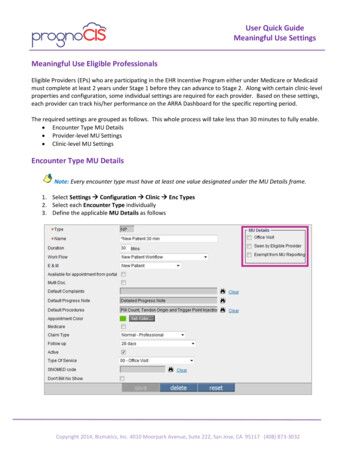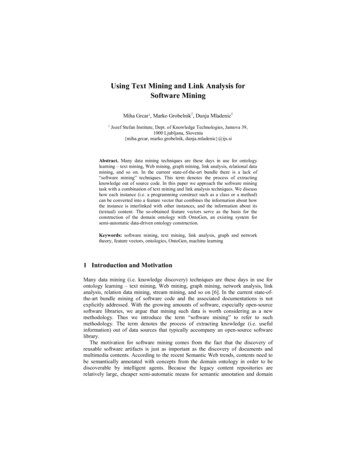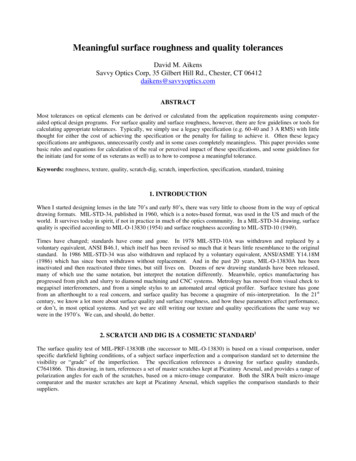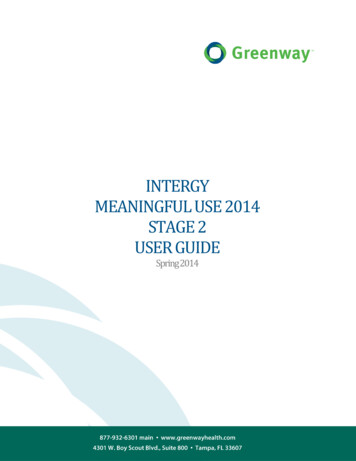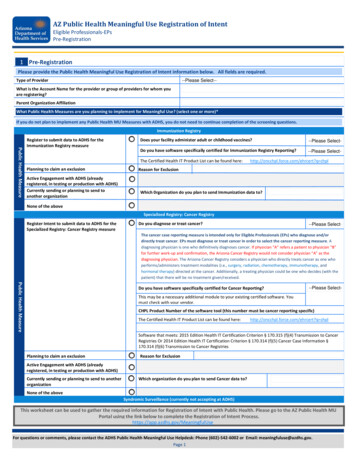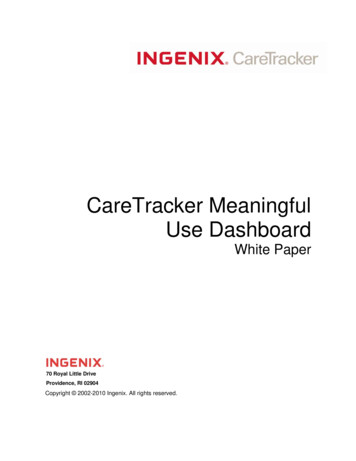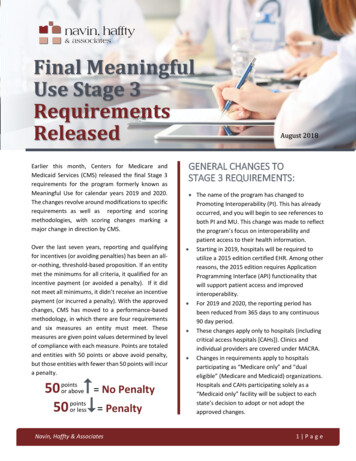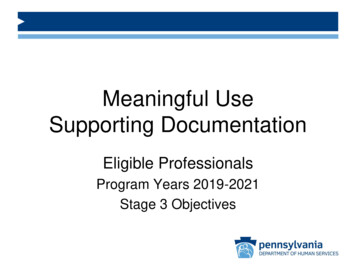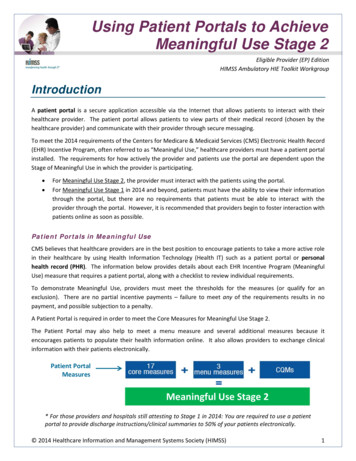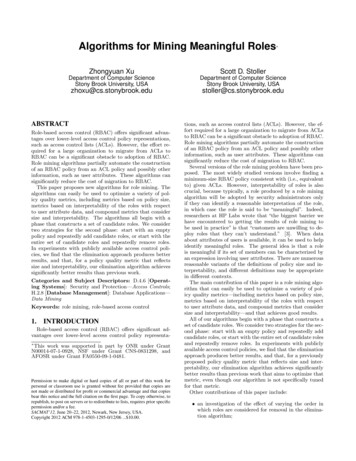
Transcription
Algorithms for Mining Meaningful Roles Zhongyuan XuScott D. StollerDepartment of Computer ScienceStony Brook University, USADepartment of Computer ScienceStony Brook University, uABSTRACTRole-based access control (RBAC) offers significant advantages over lower-level access control policy representations,such as access control lists (ACLs). However, the effort required for a large organization to migrate from ACLs toRBAC can be a significant obstacle to adoption of RBAC.Role mining algorithms partially automate the constructionof an RBAC policy from an ACL policy and possibly otherinformation, such as user attributes. These algorithms cansignificantly reduce the cost of migration to RBAC.This paper proposes new algorithms for role mining. Thealgorithms can easily be used to optimize a variety of policy quality metrics, including metrics based on policy size,metrics based on interpretability of the roles with respectto user attribute data, and compound metrics that considersize and interpretability. The algorithms all begin with aphase that constructs a set of candidate roles. We considertwo strategies for the second phase: start with an emptypolicy and repeatedly add candidate roles, or start with theentire set of candidate roles and repeatedly remove roles.In experiments with publicly available access control policies, we find that the elimination approach produces betterresults, and that, for a policy quality metric that reflectssize and interpretability, our elimination algorithm achievessignificantly better results than previous work.Categories and Subject Descriptors: D.4.6 [Operating Systems]: Security and Protection—Access Controls;H.2.8 [Database Management]: Database Applications—Data MiningKeywords: role mining, role-based access control1.INTRODUCTIONRole-based access control (RBAC) offers significant advantages over lower-level access control policy representa This work was supported in part by ONR under GrantN00014-07-1-0928, NSF under Grant CNS-0831298, andAFOSR under Grant FA0550-09-1-0481.Permission to make digital or hard copies of all or part of this work forpersonal or classroom use is granted without fee provided that copies arenot made or distributed for profit or commercial advantage and that copiesbear this notice and the full citation on the first page. To copy otherwise, torepublish, to post on servers or to redistribute to lists, requires prior specificpermission and/or a fee.SACMAT’12, June 20–22, 2012, Newark, New Jersey, USA.Copyright 2012 ACM 978-1-4503-1295-0/12/06 . 10.00.tions, such as access control lists (ACLs). However, the effort required for a large organization to migrate from ACLsto RBAC can be a significant obstacle to adoption of RBAC.Role mining algorithms partially automate the constructionof an RBAC policy from an ACL policy and possibly otherinformation, such as user attributes. These algorithms cansignificantly reduce the cost of migration to RBAC.Several versions of the role mining problem have been proposed. The most widely studied versions involve finding aminimum-size RBAC policy consistent with (i.e., equivalentto) given ACLs. However, interpretability of roles is alsocrucial, because typically, a role produced by a role miningalgorithm will be adopted by security administrators onlyif they can identify a reasonable interpretation of the role,in which case the role is said to be “meaningful”. Indeed,researchers at HP Labs wrote that “the biggest barrier wehave encountered to getting the results of role mining tobe used in practice” is that “customers are unwilling to deploy roles that they can’t understand.” [3]. When dataabout attributes of users is available, it can be used to helpidentify meaningful roles. The general idea is that a roleis meaningful if its set of members can be characterized byan expression involving user attributes. There are numerousreasonable variants of the definitions of policy size and interpretability, and different definitions may be appropriatein different contexts.The main contribution of this paper is a role mining algorithm that can easily be used to optimize a variety of policy quality metrics—including metrics based on policy size,metrics based on interpretability of the roles with respectto user attribute data, and compound metrics that considersize and interpretability—and that achieves good results.All of our algorithms begin with a phase that constructs aset of candidate roles. We consider two strategies for the second phase: start with an empty policy and repeatedly addcandidate roles, or start with the entire set of candidate rolesand repeatedly remove roles. In experiments with publiclyavailable access control policies, we find that the eliminationapproach produces better results, and that, for a previouslyproposed policy quality metric that reflects size and interpretability, our elimination algorithm achieves significantlybetter results than previous work that aims to optimize thatmetric, even though our algorithm is not specifically tunedfor that metric.Other contributions of this paper include: an investigation of the effect of varying the order inwhich roles are considered for removal in the elimination algorithm;
an algorithm for synthesizing user attribute data. Theuse of synthetic user attribute data in experiments isregrettable but currently unavoidable, due to the lackof publicly available real user attribute data.2.PROBLEM DEFINITIONThis section defines the role mining problems that we consider. Our definitions are similar to those in [9].Policies and Policy Quality.An ACL policy is a tuple hU, P, UP i, where U is a set ofusers, P is a set of permissions, and UP U P is theuser-permission assignment.An RBAC policy is a tuple hU, P, R, UA, PA, RH i, whereR is a set of roles, UA U R is the user-role assignment,PA R P is the permission-role assignment, and RH R R is the role inheritance relation. Specifically, hr, r0 i RH means that r is senior to r0 , hence all permissions ofr0 are also permissions of r, and all members of r are alsomembers of r0 .An RBAC policy with direct assignment is a tuple hU, P, R,UA, PA, RH , DAi, which is an RBAC policy extended witha direct user-permission assignment DA U P . Allowing direct assignment of permissions to users provides moreflexibility to handle anomalous permissions.An RBAC policy is consistent with an ACL policy if UA PA UP , where is composition of relations. An RBACpolicy with direct assignment is consistent with an ACL policy if UA PA DA UP .User-attribute data is a tuple hA, f i, where A is a set ofattributes, and f is a function such that f (u, a) is the valueof attribute a for user u. For simplicity, we assume that allattribute values are natural numbers.A policy quality metric is a function from RBAC policies (or RBAC policies with direct assignment) to a totallyordered set, such as the natural numbers. The ordering ischosen so that small values indicate high quality; this mightseem counter-intuitive at first glance, but it is natural formetrics such as policy size. We define two basic policy quality metrics and then consider combinations of them.Weighted Structural Complexity (WSC) is a generalizationof policy size [9]. For an RBAC policy π of the above form,we define weighted structural complexity by WSC(π) w1 R w2 UA w3 PA w4 RH , where s is the size(cardinality) of set s, and the wi are user-specified weights.For an RBAC policy with direct assignment, the definitionis the same except with an additional summand w5 DA .Interpretability is a policy quality metric measures howwell the roles in the policy can be characterized (interpreted)in terms of user attributes. Specifically, we quantify policyinterpretability as attribute mismatch, which measures howwell the sets of members of the roles can be characterizedusing expressions over user attributes. An attribute expression e is a function from the set A of attributes to setsof values. A user u satisfies an attribute expression e iff( a A. f (u, a) e(a)). For example, if A {dept, level },the function e with e(dept) {CS} and e(level ) {2, 3}is an attribute expression, which can be written with syntactic sugar as dept {CS} level {2, 3}. We refer tothe set e(a) as the conjunct for attribute a. Let [[e]] denotethe set of users that satisfy e. For an attribute expressione and a set U 0 of users, the mismatch of e and U 0 , denotedmismatch(e, U 0 ), is the size of the symmetric difference of [[e]]and U 0 , where the symmetric difference of sets s1 and s2 iss1 s2 (s1 \s2 ) (s2 \s1 ). The attribute mismatch of a roler, denoted AM(r), is mine E mismatch(e, assignedU(r)), whereE is the set of all attribute expressions, and assignedU(r) {u hu, ri UA}. The attribute mismatch of an RBACpolicyπ (with or without direct assignment) is AM(π) Pr R AM(r). We define policy interpretability INT as attribute mismatch, i.e., INT(π) AM(π).Compound policy quality metrics take multiple aspects ofpolicy quality into account. One approach is to combinemultiple policy quality metrics using a weighted sum; however, the choice of weights may be difficult or arbitrary. Wecombine metrics by Cartesian product, with lexicographicordering on the tuples. Let INT-WSC(π) hINT(π), WSC(π)iand WSC-INT(π) hWSC(π), INT(π)i.Role Mining from ACLs.The problem of role mining from ACLs is: given an ACLpolicy πa and a policy quality metric Q, find an RBAC policy πr that is consistent with πa and has the best quality,according to Q, among policies consistent with πa . Theproblem of role mining with direct assignment from ACLsis the same except that πr is an RBAC policy with directassignment.Role Mining from ACLs and User Attributes.The problem of role mining from ACLs and user attributes(with or without direct assignment) is the same as for rolemining from ACLs, except that the input also includes userattribute data, which may be used in the policy quality metric.Our algorithms produce RBAC policies in which role membership is always defined by explicit user-role assignment,even when the current membership of a role can be characterized exactly by an attribute expression. In practice,assigning users to roles fully automatically based on userattributes might be risky; requiring explicit user-role assignments by an administrator is safer. The administrator’seffort can be reduced by an algorithm that suggests appropriate roles for new users, based on their attributes. Forexample, we can compute and store a best-fit attribute expression er for each role r, i.e., an attribute expression thatminimizes the attribute mismatch for r. When a new useru is added to the access control system, the system suggeststhat u be made a member of the roles for which u satisfies thebest-fit attribute expression, and it presents these suggestedroles for u in descending order of the attribute mismatch.This allows good suggestions even in the presence of noise.3.ALGORITHMSThis section presents our role mining algorithms. In general, they compute only approximate solutions to the rolemining problem: the generated RBAC policy is always consistent with the given ACL policy, but it does not alwayshave the best possible quality. This is a common limitationof role mining algorithms, because computing an optimalsolution is NP-hard for policy quality metrics of interest [9].3.1Elimination AlgorithmOur elimination algorithm has three phases. Phase 1, rolegeneration, generates a candidate role hierarchy that contains all “interesting” candidate roles. Phase 2, role elim-
1:2:3:4:5:6:7:// Create initial roles.InitRole SpermSets u U {p P hu, pi UP }for ps in permSets \ { }r new Role()InitRole InitRole {r}P A P A ({r} ps)end for// Compute all intersections of initial roles.8: R 9: for r in InitRole10: InitRole InitRole \ {r}11: for r0 in InitRole12:P assignedP(r) assignedP(r0 )13:if empty(P ) 6 r00 R. assignedP(r00 ) P14:r00 new Role()15:PA PA ({r00 } P )16:R R {r00 }17:end if18: end for19: for r0 in R20:P assignedP(r) assignedP(r0 )21:if empty(P ) 6 r00 R. assignedP(r00 ) P22:r00 new Role()23:PA PA ({r00 } P )24:R R {r00 }25:end if26: end for27:end for28:R R InitRoleFigure 1: Role generation, step 1: compute candidate roles.ination, removes roles from the candidate role hierarchy ifthe removal preserves consistency with the given ACL policy and improves policy quality. Phase 3, role restoration,adds some removed roles back to the policy, if this improvespolicy quality.Phase 1: Role Generation.Our algorithm for role generation is based closely on CompleteMiner [14], although for increased scalability, we couldeasily substitute FastMiner [14] or the FP-Tree approach [5,10]. Roles are characterized primarily by the set of permissions assigned to the role. An initial role has a set ofpermissions that contains all permissions assigned to someuser. A candidate role has a set of permissions obtained byintersecting the permission sets of an arbitrary number ofinitial roles. As argued in [14], in the absence of other information on which to base the construction of candidateroles, this method generates all interesting candidate roles.Pseudo-code for this construction appears in Figure 1. It isessentially the same as the pseudo-code for CompleteMinerin [14]. It uses the functions assignedP(r) {p P hr, pi PA} and assignedU(r) {u U hu, ri UA}.CompleteMiner does not produce a role hierarchy. Our algorithm computes a role inheritance relation with the maximum amount of inheritance: a candidate role rp inheritsfrom another role rc whenever the permissions of rp are asuperset of the permissions of rc . Furthermore, when that// Initialize variables. Assign users to roles.1: UA ; RH 2: for u in U3:P {p P hu, pi UP }4:for r in R5:if authP(r) P6:UA UA {hu, ri}7:end if8:end for9: end for// Add inheritance edges, and eliminate inherited// permissions and members from UA and PA.10:for r in R11: parents {r0 R hr, r0 i RH } // parents of r12: for r0 in R \ {r}13:if authP(r0 ) authP(r)14: r00 parents. authP(r0 ) 6 authP(r00 )15:RH RH {hr, r0 i}16:for hr, pi in PA17:if p authP(r0 )18:PA PA \ {hr, pi}19:end if20:end for21:for hu, r0 i in UA22:if u assignedU(r)23:UA UA \ {hu, r0 i}24:end if25:end for26:for r00 in parents27:if authP(r00 ) 6 authP(r0 )28:RH RH \ {hr, r00 i}29:end if30:end for31:end if32: end for33:end forFigure 2: Role generation, step 2: construct rolehierarchy, based on R and PA from step 1.inheritance relation is introduced, the permissions inheritedby rp from rc are removed from the permissions explicitlyassigned to rp by PA, and the members inherited by rc fromrp are removed from the members explicitly assigned to rcby UA. Pseudo-code appears in Figure 2. It uses functionsauthP(r) {p P r0 R. hr, r0 i RH hr0 , pi PA}and authU(r) {u U r0 R. hr0 , ri RH hu, r0 i UA}, where RH is the reflective transitive closure of RH .A role hierarchy has full inheritance if every two rolesthat can be related by the inheritance relation are relatedby it, i.e., r, r0 R. authP(r) authP(r0 ) authU(r) authU(r0 ) hr, r0 i RH . Guo et al. call this propertycompleteness [4].All of our algorithms generate RBAC policies with fullinheritance. Although relaxing this requirement would allow our algorithms to achieve better policy quality in somecases, we impose this requirement, because in the absence ofother information, all of these possible inheritance relationships are equally plausible, so removing any of them risksremoving some that are semantically meaningful and desirable.
Phase 2: Role Elimination.Roughly, the role elimination phase removes roles fromthe candidate role hierarchy if the removal preserves consistency with the given ACL policy and improves policy quality.When a role r is removed, the role hierarchy is adjusted topreserve inheritance relations between parents and childrenof r, and the user assignment and permission assignment areadjusted to explicitly assign to other roles the members andpermissions that they previously inherited from r.The order in which roles are considered for removal is important, because it may lead to different RBAC policies inthe end. We control this ordering with a role quality metricQrole , which maps roles to an ordered set, with the interpretation that large values denote high quality (note: thisis opposite to the interpretation of the ordering for policyquality metrics). Low-quality roles are considered for removal first. The algorithm is parameterized by the choiceof role quality metric. We consider three basic role qualitymetrics and then consider combinations of them.Clustered size measures how well user permissions are clustered in the role. A first attempt at formulating such ametric might simply be the total number of UP pairs (i.e.,elements of the UP relation) that are covered by the role,or, equivalently but with the metric normalized to be in therange [0, 1], the fraction of all UP pairs covered by the role.However, such a metric would give the same rating to a roler1 that covers one permission for each of 10 users and arole r2 that covers 5 permissions for each of 2 users, eventhough r2 is preferable; for example, if all of the users haveexactly 5 permissions, then the two users in r2 would notneed to belong to any other roles, while all of the users inr1 would need to belong to other roles as well. To take thisinto account, we define the clustered size metric to equalthe fraction of the permissions of the role’s members thatare covered by this role; formally,1: π policy produced by role generation2: q Qpol (π)3: workList list containing removable roles in π4: changed true5: while empty(workList) changed6:sort workList in ascending order by Qrole7:changed false8:for r in workList9:if removable(r)10:remove r from workList11:else12:π 0 removeRole(π, r)13:q 0 Qpol (π 0 )14:if q 0 δq15:π π016:q q017:changed true18:remove r from workList19:end if20:end if21:end for22: end whilefunction removeRole(π, r)23: hU, P, R, UA, PA, RH i π24: R R \ {r}25: for hr1 , ri in RH26:RH RH \ {hr1 , ri}27:for hr, r2 i in RH28:if hr1 , r2 i 6 RH 29:RH RH {hr1 , r2 i}30:end if31:end for32:for hr, pi in PA33:if p 6 authP(r1 )34:PA PA {hr1 , pi}35:end ifassignedUP(r) {hu, pi UP u assignedU(r)36:end for p assignedP(r)}clsSz(r) assignedUP(r) {hu, pi UP u assignedU(r)} 37: end for38: for hr, r2 i in RHThe numerator considers assigned users and permissions, in39:RH RH \ {hr, r2 i}stead of authorized users and permissions, so that a role gets40:for hr, ui in UAcredit only for the UP pairs that it covers by itself, not for41:if u 6 authU(r2 )UP pairs covered by its ancestors or descendants.42:UA UA {hr2 , ui}Attribute fitness measures how well the set of members43:end ifof a role can be characterized (interpreted) in terms of user44:end forattributes. It is based on attribute mismatch, defined in45: end forSection 2, normalized to be in the range [0, 1] and subtracted46: return hU, P, R, UA, PA, RH ifrom 1 so that higher values of the metric indicate higherAM(r).quality; formally, attrFit(r) 1 assignedU(r) Figure 3: Role elimination.Redundancy measures how many other roles also cover theUP pairs covered by a role. Removing a role with higherCompound role quality metrics can be formed in the sameredundancy is less likely to prevent subsequent removal ofways as compound policy quality metrics, e.g., max(clsSz,other roles, so we eliminate roles with higher redundancyattrFit).first. Values of the redundancy metric are pairs, with lexOur algorithm may remove a role even if the removal worsicographic order. The redundancy of role r is the negativeens policy quality slightly. Specifically, we introduce a qua
Role Mining from ACLs and User Attributes. The problem of role mining from ACLs and user attributes (with or without direct assignment) is the same as for role mining from ACLs, except that the input also includes user-attribute data, which may be used in the policy quality met-ric
